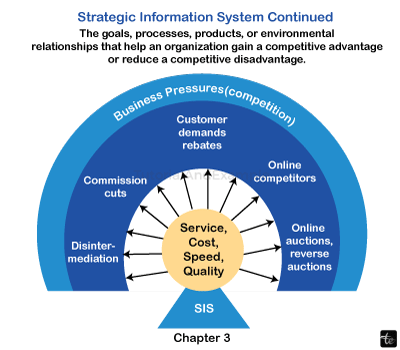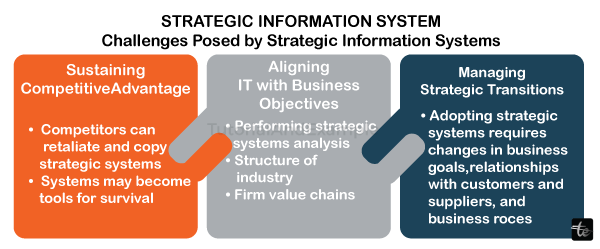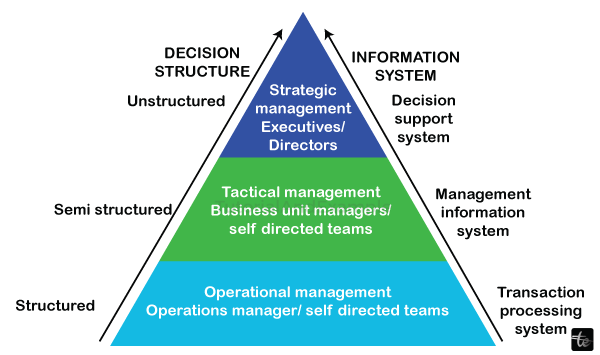Information System for Strategic Advantage
Definition of Information Systems
Information System (IS) implies an interested unit composed of hardware and software modules deployed within an organization to serve the purpose of collecting, storing, processing, and transferring data and information. Such systems join together people, processes, and technologies that enable organizations to conduct their operations effectively and better.
Beyond this, Information System is a combination of hardware, software, data, processes, and people. The hardware part involves these distinct components as computers, servers, networking devices, and other physical infrastructures. Data Arrays comprise packages and applications supported by the software. The data being referred to are the facts and the figures collected by the system and kept in the memory. Processes should describe expectations and rules of usage of the system, whereas people are the users and other parties concerned with its working.
 Importance of Information Systems in Organizations
Importance of Information Systems in Organizations
- Improved Efficiency: An Information System facilitates the completion of repetitive jobs, mechanizes teamwork, and empowers automation of processes that would otherwise be manually performed, thus creating a system with optimum operational efficiency.
- Enhanced Decision Making: The management may review a large amount of dynamic and accurate data that will help them make prompt decisions based on relevant information and insights.
- Strategic Advantage: Organizations that use information technologies competently secure an advantage over others through simultaneous and proper alignment of technology with business priorities to foresight market tendencies and timely respond to shifts in the competition space.
- Increased Productivity: IS eases working facility and sharing among employees. It makes making productivity rates higher than before and resource utilization.
- Customer Satisfaction: Through in-depth data capturing and processing, IS facilitates mass customization of products, services, and promotions to increase personalized user interactions which increases the customer satisfaction and intensity.
- Innovation Catalyst: The Information Systems allow experimentation, prototyping, and quick trials with new ideas and business models that identify innovation.
 What is Strategic Advantage?
What is Strategic Advantage?
Sometimes, organizations that possess this strategic advantage are able to lift their competitive positions in the market place above their competitors, ensuring long-term success.
Here's an overview:
- Differentiation: The key factor of exploiting a competitive edge usually comes from the way one is capable of distinguishing their products, services, or processes in an asset that gives greater value to customers than competitors can deliver. Diversification can be rendered in terms of quality, innovation, customization, or brand reputation.
- Cost Leadership: Another lever of competitive advantage is cost leadership, where an organization can produce products at a level price that is lower than competitors offer them and still maintain profitability.
- Market Focus: Strategic advantage can also be attained by using the market focus approach, where an enterprise is targeted at specific segments of customers, niche markets, or certain geographic areas that are not catered to by competing firms and have special requirements, thus facilitating prescribed solutions that enhance customer loyalty.
- Resource Allocation: Strategic advantage can either be good or bad depending on how the allocation of resources, including money, people, and tech investments, is done to back their strategic goals and long-term aspirations.
Transaction Processing Systems (TPS)
Today's Transaction Processing Systems (TPSs) are an integral piece of information systems. Businesses use these systems to streamline the processing and management of their everyday transactions.
Here's an in-depth look at TPS:
Definition
TPS is considered a category of information system that helps the organization conducting financial deals to store and retrieve all the requisite data. Transactions include an order, an adjustment of inventory, financial transactions, payroll, and so on.
Key Components
- Input: TPS is supplied with different kinds of transaction data from different sources like Cash registers, online purchase processes, quantity sensors, and manual input data entry.
- Processing: There is no objection being made as transaction data undergo a process to make sure they are valid, recorded, and updated in either the databases or files.
- Storage: Data obtained from processing is kept in the form of database(s) or (the) file(s) used for past investigations or analysis.
- Output: TPS gives out reports, receipts, invoices, or any other data with the transaction data, which can then be used to make better decisions and for keeping accounts.
Functions
- Data Capture: TPS supplies records of transactions at the moment when they occur or soon after and allows ledgers to be maintained with accurate and timely entries of operations.
- Data Processing: These are processed with efficiency using predefined methods and procedures to ensure every information therein is correct and consistent.
- Data Storage: The processed data is naturally stored securely in the databases or files, meaning that it can be summoned and analyzed at any time when required.
- Data Retrieval: TPS is designed to get trouble-free transaction data that helps users prepare both regular and real-time reporting and make analysis and decision-making faster.
Role in Organizations
- Operational Support: TPS performs day-to-day business operations such as a one-click button for repetitive tasks, which reduces human errors and also provides swiftness in the processing of transactions.
- Decision Support: TPS provides companies with crucial transactional reports, analysis, and metrics to give managers information to formulate inferences, measure performance, and identify tendencies or flukes.
- Customer Service: The above will benefit the customer service of the business by having orders processed on time, correct billing, and addressing customer queries or problems quickly when they arise.
Management Information Systems (MIS)
Management Information Systems (MIS) are now one of the key elements of organizational infrastructure that allows managers to make use of the tools, ones they need to make informed decisions and lead the organization to its strategic goals
Definition
MIS is commonly regarded as an informational system that helps to collect, process, store, and disseminate information so that managers at all levels can use it to facilitate decision-making.
Key Components
- Data Collection: Data that MIS draws from different internal and external sources can be in the form of computers, scanners, etc. The questionnaires or the market studies are also its sources sometimes.
- Data Processing: That is the job of data processing, which has the challenge of transforming the data obtained into a pure sense of understanding that aims at the development of a report.
- Data Storage: A data scientist will then feed the created data into the databases or data warehouse systems that are often used for the extraction of data.
- Information Dissemination: MIS will be used by the system's audiences, who are likely to be the ones affected by the admission since it transmits data.
Functions
- Decision Support: Some types of management information systems in the run for managers bring them scheduled reports concerning various operational processes like strategic planning, allocating resources, overseeing them, and, finally, performance evaluation.
- Performance Monitoring: Tracking metrics of operational performance and service characteristics serves for evaluation of an organization to maintain operations and performance.
- Forecasting and Prediction: Utilizing MIS analytics brings up forward-looking modeling and action planning as well as quickness in reacting to hitherto unattended challenging situations with proofed and well-thinking decisions.
- Resource Management: MIS helps in handling operational requirements by aligning them to make the organization's resources suitable for conveying the needs. Resources in place include human resources, finance, and materials.
Role in Organizations
- Operational Efficiency: This is because MIS reduces the size of paperwork optimizes businesses, and some cases repeat failures that humans introduce, as a consequence of which the speed of the workflow and efficiency of the employees improves.
- Strategic Planning: The MIS thus via statistical data that concern themselves with trends in markets, activities of competitors and customers. This aids in the decision-making, prioritization, and subsequent success of a venture (business).
- Risk Management: MIS defines risks and risks and vulnerabilities within the organization; this manager grades all damages and brings opportunities to light.
- Performance Evaluation: MIS also facilitates performance measurement and evaluation that lets managers singly keep an eye on performance to goals and aspects of the business.
 Decision Support Systems (DSS)
Decision Support Systems (DSS)
DSS, a Decision Support System, is an electronic stability apparatus developed to empower managers in making semi-refined and refined decisions.
Here's a comprehensive overview of DSS:
Definition
DSSs, which are interactive computerized systems, help decision-makers facing the most complex cases to get the information, tools for data analysis, and procedures for decision-making they need.
Components
- Database: A MIS employs the use of a database to stock data. This includes internal and any sorts of external processes that are related to decision-making.
- Model Base: Rule-based-driven system includes processes, simulations, and rules for decision-making that can be used to examine data and determine signals.
- User Interface: DSS facilitates people's interaction with the system by letting decision-makers get information from the system, parameters, and multiple decision options through an intuitive interface.
- Decision Support Engine: DSS uses cutting-edge analytical tools like data mining, predictive modeling, and optimization to devise the best solution by showing what the benefits and consequences would be in each of the available option pathways.
- Knowledge Base: DSS may consist of a data knowledge base for storing information in various forms, including expert knowledge, rules, and process concepts involved in the decision-making domain.
Functions
- Data Analysis: DSS (Data Scientific Specialist) can create hidden discoveries from historical and real-time data resources to expose better trends, correlations, and a cause-and-effect relationship that can further impact the decision-making process.
- Scenario Analysis: DSS enables users to hand in, and make trials and errors for the data that was being suggested. Then, they can measure accordingly the effects that taking other choices will likely have.
- What-If Analysis: DSS applies diverse input variables and settings to model hypothetical events that may have been which players can follow to see the consequent actions on a given occurrence.
- Decision Modeling: DSS, in its essence, is an element of the automation of decision-making processes, the schemes of the help of which can be seen as algorithms in various fields forecasting, budgeting, risk management, and so on.
- Visualization: DSS alerts visualized data and graph/chart views to top off the comprehension.
Role in Organizations
- Strategic Decision-Making: DSS gives senior managers a more significant share in developing strategic plans, determining goals, and laying out budgets done hence but much more efficiently.
- Tactical Planning: DSS helps middle-level managers prepare specific plans, execute and monitor indicators, and make senior-level operational changes.
- Problem-Solving: The use of Data Science in the decision-making process at all organizational levels assists in addressing complicated problems, settling conflicts, and developing strategies for the well-being of the organization.
- Risk Management: DSS assists in identifying risks, analyzing possible consequence scenarios, and creating protection measures to reduce undesirable outcomes or incidents.
Enterprise Resource Planning (ERP)
Enterprise Resource Planning systems or ERP are software applications that are integrated to facilitate automation and coordination of business processes across different departments and the whole organization.
Here's a detailed overview of ERP systems:
Definition
ERP systems are generalized software platforms, which are used for centralizing and standardizing data flows. They also allow for continuous data communication between various departments and ensure continuous monitoring of vital business operations.
Key Features
- Centralized Database: As a matter of fact, ERPs (Enterprise Resource Planning) consist of a single, unified database, which is one of the sources of the data belonging to different functional areas such as finance, human resources, supply chain, manufacturing, and customer relationship management.
- Integration: Following the integration of different business processes and processes, ERP solves the problem of creating information pockets and data duplication.
- Automation: The role of enterprise resource planning is to automate manual tasks and workflows, which is the job of order entry to shipping. In this case, there is no manual effort, and time spent on operation is minimal.
- Reporting and Analytics: The ERP systems come along with the reporting and analytics tools to search for data and to produce insights, which in turn support data-driven decision making.
- Scalability: ERPs are scalable and thus can accommodate the needs of businesses developing over time, offering companies the ability to add new modules and functionalities when necessary.
- Customization: ERP systems are operator-friendly to make the software perfectly match the needs and the processes of the organization.
- Security: The ERP system has its robust security features that facilitate data confidentiality while setting up compliance measures against the legislative framework.
Modules
- Finance and Accounting: Take care of the money dealing such as transactions, budgeting, payroll, and financial reporting.
- Human Resources: Process employee data; organize recruitment, train, performance management and payroll processing.
- Supply Chain Management: Plan the procurement process, optimize the inventory, and facilitate order fulfillment and last-mile logistics.
- Manufacturing: Minimize production planning, scheduling, quality control, and shop-floor operations by simplifying production management.
- Customer Relationship Management (CRM): Monitor customer interactions, help with sales leads, and liaise between different departments in sales and marketing.
- Business Intelligence (BI): Offer data processing, grounds for reporting, and illustration framework to boost the strategic resolution-making process.
Benefits
- Improved Efficiency: ERP systems play the role of a tool that automate the routine business processes and simplify them to cut out activities carried out manually, and, hence, increases the productivity and efficiency of the business.
- Enhanced Visibility: ERP systems are the source of immediate insights into key business values and indicators of profitable patterns, thus allowing for smarter decision-making and strategic planning.
- Cost Savings: Broadening process automation, eliminating human errors and better resource management are factors that enable ERP systems to diminish the costs of operation while at the same time increasing the business profitability.
- Scalability: ERP systems can be built on company development and changing business requirements and they can provide support in entering new markets or new product lines.
Challenges
- Implementation Complexity: ERP implementation may be complex and time-consuming due to the significant need for proper planning, tailoring, and user training.
- Integration Issues: ERP systems integration could bring problems like complexities with legacy systems or poor compatibility with third-party applications that lead to discrepancies in data.
Challenges and Considerations in Leveraging Information Systems for Strategic Advantage
- Data Security and Privacy: As processing volumes of data become more and more proceeding, there is no doubt that organizations should make the security and privacy of data their primary concern. The need for implementing robust cybersecurity adequately protecting sensitive data, preventing cyber security attacks and data breaches, as well as complying with GDPR and CCPA demands is mandatory.
- Integration Complexity: Integration of fragmented systems, applications, and data sources is a very critical factor, which presents a challenge for relationships. Legacy systems, fragmented data, and disparate technologies are obstacles on the way to full-scale integration and have resulted in data divergences, operational inefficiencies, and complexity rise. Focusing on integrating platforms, APIs, and middleware solutions is a good way of minimizing issues during the integration of the system and data transfer across the entire organization.
- Skills Gap and Talent Shortage: Organizations always need more skilled workers who can ensure optimal information system control and maximum utilization. The high speed of technological change and an issue of skill shortage, mostly in data analytics, cybersecurity, and cloud computing for listed credentials, make the skills gap worse. Investing in both employee training and strategic partnerships with educational institutions (universities or schools) can be used to reduce the resulting imbalances.
Best Practices for Harnessing Information Systems for Strategic Advantage
- Align Information Systems with Business Objectives: Be certain that the IT architecture and its implementation match up with the development plans of the organization. Align the IT strategy with the business strategy as well as with market dynamics through the annual evaluation and update.
- Focus on Data Quality and Governance: Develop solid data governance practices to preserve the authenticity and freshness of the data in the organizational ambiance. Data quality controls, metadata management, and data provenance make the data useful and agreeable for proper institutions and authorized personnel based on environment compliance.
- Embrace Open Standards and Interoperability: fostering compliance with open standards and interoperable technologies is a crucial factor for better system transactions and data sharing between distinct systems and platforms. Devolve the vendor lock-in executive solution by using the ones that adhere to industry standards and allow the vendor-neutral architecture.
- Prioritize Security and Privacy: Develop a holistic cybersecurity system that can protect confidential data, guard against cyber threats, and be in line with regulatory requirements. Gear up for frequent security assessments, vulnerability scans, and penetration tests that bring the possible risks to the forefront and mitigate them.
Conclusion
In conclusion, information technology systems are among the major players in the strategic advantage of organizations during the present competitive environment. Applications of tools like transaction systems, decision support tools, and management information systems, together with the planning and managing of enterprise resources, help to make operations more efficient and decision-making easier. Organization of the information systems according to business goals, investment in personnel training and competencies development, and devotion to lean operation approaches are the foundation of the positive outcome. In addition, the ability to make decisions based on quality data, secure data storage and exchange, and privacy protection, as well as collaboration and knowledge sharing, would be the main factors in the use of information systems for a competitive edge.